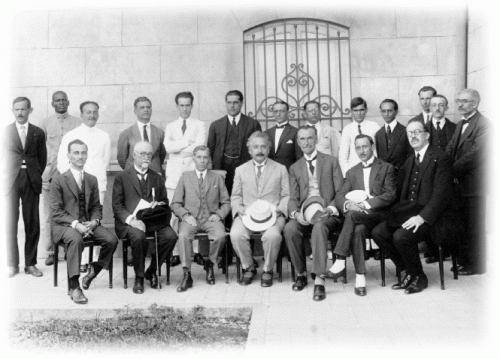
Einstein visiting Brazil’s National Observatory in 1925. (Courtesy: Observatório Nacional)
By Matin Durrani in Rio de Janeiro
I don’t think I’ve ever talked to the head of a physics lab with a parrot screeching outside the window. But that was the case today when I visited the Brazil’s National Observatory – the country’s oldest scientific institution, founded in 1827 by Emperor Dom Pedro I just five years after the country won independence from Portugal.
The parrot was somewhere in the lush green trees directly outside the open windows of the director’s elegant first-floor office, which is currently occupied by the physicist Joao dos Anjos, who took over as head of the observatory earlier this year. (He also claimed his secretary had seen a ghost in the office recently, but that’s another story.)
After closing the windows’ shutters and switching on the air-conditioning, Dos Anjos explained how the observatory is now focused on three main activities – astronomy, geophysics and metrology. In fact, the observatory is still the official body in Brazil for setting time, which was one of its original missions, along with determining geographical locations and studying the country’s climate.
The observatory has a long and successful history – and was visited in May 1925 by Einstein himself, shortly after the famous eclipse in South America that confirmed his general theory of relativity.
Today, though, the remit of the observatory has expanded to include a good deal of work with industry, with several projects involving mapping potential on-shore and off-shore oil reserves in partnership with the Brazilian oil giant Petrobras and the British multinational BP.
After lunch of Portuguese salted cod, Dos Anjos showed me round the observatory’s delightful museum, which is housed in a beautiful two-storey building with a grand sweeping staircase boasting a huge stained-glass window half-way up.
I then talked to Daniela Lazarro, who in 2006 was one of the astronomers who successfully called for Pluto to be renamed as a “dwarf planet” and who in 2009 was co-chair of the national organizing committee for that year’s International Astronomical Union meeting in Rio, which was the culmination of the International Year of Astronomy. Lazarro has also helped to set up the OASI observatory in a remote part of north-eastern Brazil, where humidity is at its lowest in the country, to look for small bodies in the solar system, such as comets and asteroids.
I also had a chat with the observatory’s previous boss, the geophysicist Sergio Luiz Fontes, who originally did a PhD at the University of Edinburgh in the UK. But when I asked him if today’s Brazilian students are keen to go abroad, he hinted that many prefer to stay in the country because jobs, particularly for geophysicists, are in ready supply; although he added that staying in Brazil can mean you’re too far away from the rest of the world. Well on a hot, sunny day like today when you can go swimming at the fabulous Cocacabana beach, as I later did, I’m not sure being far away from everywhere else really matters.
Metrology or meteorology?
Metrology of time and frequency.
according to me must exist some entanglement constant or distribution function that play role in decoherence. If we have millions of atoms entangled in crystal exist some time function of their decoheration. So in the same physical conditions the decoheration of particles must be the same in time. That is why we can use entangled crystal as probe for measuring of entangle environment as quality of physical environment. We can measure by this entangled crystal entanglement quality of surroundings. For example we can also compare liquid gases that have different temperature and different chemical compounds from view of entanglement quality. Last thing ( can we have mixture of different liquid gases )?
I am sorry I do not know Einstein GTR, but cant exist symetrical theory with antigravity as core of this theory??